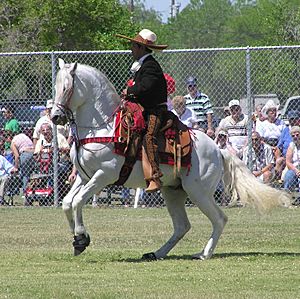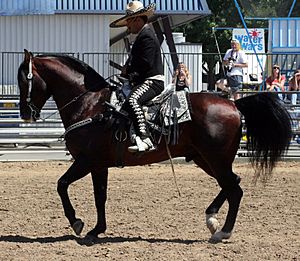Azteca horse facts for kids

Azteca horse
|
|
| Country of origin | Mexico |
|---|---|
| Horse (Equus ferus caballus) | |
The Azteca is a special horse breed that comes from Mexico. There is also a type called the "American Azteca" found in the United States. These horses are strong and well-muscled. They can be almost any solid color. The American Azteca can also have Paint colors, which means they have patches of white and another color.
Azteca horses are known for competing in many western riding and some English riding sports. The rules for registering these horses are a bit different in Mexico compared to the United States. For example, the types of parent horses allowed and the need for physical checks can vary. The Azteca breed was first created in Mexico in 1972. It was made by mixing three other horse breeds: the Andalusian, the American Quarter Horse, and the Mexican Criollo. Later, in the United States, American Paint Horse blood was added to the American Azteca type.
Contents
What Makes an Azteca Horse Special?
The Azteca horse was created from three main breeds: the Andalusian, the American Quarter Horse, and the Mexican Criollo. These breeds were chosen to make a horse that is athletic, has a good temper, and looks a certain way.
Size and Looks
Male Azteca horses (called stallions or geldings) are usually between 15 and 16.1 hands (60 and 65 inches, 152 and 165 cm) hands tall at the withers (the highest part of their back, at the base of the neck). Female Azteca horses (called mares) are between 14.3 and 16 hands (59 and 64 inches, 150 and 163 cm) hands tall. The perfect height is usually between 14.3–15.1 hands (59–61 inches, 150–155 cm) hands. Both male and female Aztecas typically weigh from 1,000 to 1,200 pounds (450 to 540 kg).
Their face usually has a straight or slightly curved (convex) profile. Their neck is often a bit arched. Overall, they are very muscular horses. They have a wide back end (called a croup) and a broad chest. Their shoulders are long and sloped.
Movement and Colors
Azteca horses move freely and easily. They have a natural way of carrying themselves (called collection) that comes from their Andalusian ancestors. They can be found in all solid colors, but gray is seen most often. White markings are allowed on their face and lower legs. The American Azteca registry also allows horses with pinto (non-solid) coloring.
How Horses Get Registered
The rules for registering Azteca horses are different in Mexico and the United States.
Mexican Registration Rules
In Mexico, an Azteca horse cannot have more than 75 percent of its blood from any one of the three main breeds (Andalusian, Quarter Horse, or Mexican Criollo). Criollo blood can be no more than 50%. Horses are put into six different groups (A through F) based on their parents. Only certain mixes between these groups are allowed.
In Mexico, Azteca horses must also meet a strict physical standard. This standard is set by the Mexican agriculture ministry. Young horses (foals) are checked at seven months old to get a "birth certificate." If a foal does not meet the standards, it might not be registered, even if its parents are registered Aztecas. For a horse to be fully registered and approved for breeding, it must pass a second, more detailed check when it is three years old or older.
American Registration Rules
In the American Azteca registry, horses with American Paint Horse (APHA) blood are also allowed. However, horses with more than 25 percent Thoroughbred blood in their family tree (which is common in many Paints and Quarter Horses) cannot be registered. American Aztecas have four registration groups based on how much blood they have from each main breed. The goal is to have a mix of about 3/8 Quarter Horse and 5/8 Andalusian. Unlike in Mexico, American Azteca horses do not need to pass physical checks before they are registered.
History of the Azteca Horse
The Azteca horse was first bred in 1972. It was created to be a horse for charros, who are traditional Mexican horsemen. Antonio Ariza Cañadilla and others were very important in making the Azteca the national horse of Mexico. It was officially recognized by the Mexican government on November 4, 1982.
Ariza used Andalusian horses imported from other countries, and crossed them with Quarter Horses and Criollos. He started breeding the first Azteca horses at Rancho San Antonio near Texcoco, Mexico. Early on, breeders realized they needed a clear plan to breed horses that all had the right characteristics. So, the Azteca Horse Research Center was created at Lake Texcoco. Working with breeders, they developed the look of the Azteca breed we see today. The very first official Azteca horse was a stallion named Casarejo. He was born in 1972 and was a mix of an Andalusian stallion named Ocultado and a Quarter Horse mare named Americana.
The Associacion Mexicana de Criadores de Caballos de Raza Azteca (Mexican Breeders Association for the Azteca Horse) is the original group that registers the breed. They still keep the international records. The International Azteca Horse Association was formed in 1992. Most Azteca horses are found in Mexico. As of 2005, the Mexican association had registered between 10,000 and 15,000 horses. They add about 1,000 new horses each year.
The Azteca Horse Registry of America was started in 1989 to register the breed in the United States. This was followed by the Azteca Horse Owners Association in 1996. The American registry has slightly different rules for registering and breeding. It is not approved by the Mexican government to register Azteca horses. The American registry, now called the American Azteca Horse International Association, allows the use of American Paint horses. These are basically Quarter Horses with pinto coloring, as long as they have less than 25 percent Thoroughbred blood. However, the U.S. registry does not include Criollo bloodlines. The Mexican registry only allows Quarter Horse, Andalusian, and Criollo blood in its registered Aztecas.
What Azteca Horses Are Used For
Because of the strong and athletic breeds that make up the Azteca, they are known for their athletic abilities. They are often seen competing in western riding events like reining, cutting, team penning, and roping. They also do well in English riding events such as dressage. You might also see them in other sports like polo and even bullfighting. Besides sports, they are also popular for pleasure riding.
See also
 In Spanish: Caballo Azteca para niños
In Spanish: Caballo Azteca para niños



